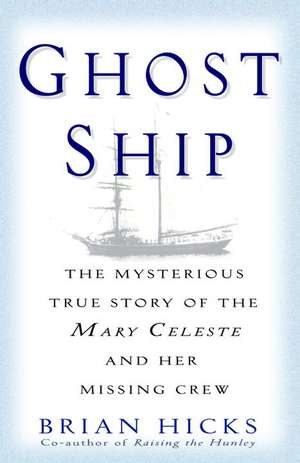Ghost Ship: The Mysterious True Story of the Mary Celeste and Her Missing Crew
Autor Brian Hicksen Limba Engleză Paperback – 31 mai 2005
The Mary Celeste was cursed as soon as she was launched on the Bay of Fundy in the spring of 1861. Her first captain died before completing the maiden voyage. In London she accidentally rammed and sank an English brig. Later she was abandoned after a storm drove her ashore at Cape Breton. But somehow the ship was recovered and refitted, and in the autumn of 1872 she fell to the reluctant command of a seasoned mariner named Benjamin Spooner Briggs. It was Briggs who was at the helm when the Mary Celeste sailed into history.
In Brian Hicks’s skilled hands, the story of the Mary Celeste becomes the quintessential tale of men lost at sea. Hicks vividly recreates the events leading up to the crew’s disappearance and then unfolds the complicated and bizarre aftermath—the dark suspicions that fell on the officers of the ship that intercepted her; the farcical Admiralty Court salvage hearing in Gibraltar; the wild myths that circulated after Sir Arthur Conan Doyle published a thinly disguised short story sensationalizing the mystery. Everything from a voodoo curse to an alien abduction has been hauled out to explain the fate of the Mary Celeste. But, as Brian Hicks reveals, the truth is actually grounded in the combined tragedies of human error and bad luck. The story of the Mary Celeste acquired yet another twist in 2001, when a team of divers funded by novelist Clive Cussler located the wreck in a coral reef off Haiti.
Written with the suspense of a thriller and the vivid accuracy of the best popular history, Ghost Ship tells the unforgettable true story of the most famous and most fascinating maritime mystery of all time.
From the Hardcover edition.
Preț: 111.10 lei
Nou
Puncte Express: 167
Preț estimativ în valută:
21.26€ • 22.31$ • 17.65£
21.26€ • 22.31$ • 17.65£
Carte disponibilă
Livrare economică 20 martie-03 aprilie
Preluare comenzi: 021 569.72.76
Specificații
ISBN-13: 9780345466655
ISBN-10: 0345466659
Pagini: 288
Ilustrații: illustrations
Dimensiuni: 134 x 204 x 18 mm
Greutate: 0.22 kg
Editura: BALLANTINE BOOKS
ISBN-10: 0345466659
Pagini: 288
Ilustrații: illustrations
Dimensiuni: 134 x 204 x 18 mm
Greutate: 0.22 kg
Editura: BALLANTINE BOOKS
Notă biografică
Brian Hicks, a senior writer with The Post and Courier in Charleston, South Carolina, is the co-author of two previous books on maritime subjects: Raising the Hunley: The Remarkable History and Recovery of the Lost Confederate Submarine and Into the Wind: The Story of the World’s Longest Race. The recipient of the South Carolina Press Association’s award for Journalist of the Year, Hicks lives in Charleston with his wife and their son.
From the Hardcover edition.
From the Hardcover edition.
Extras
Chapter One
A Simple, Handsome Ship
For as long as he lived, George Spicer was haunted by the sight of a worried young woman running along the Nova Scotia shore.
It was a summer morning in June of 1861, when Spicer was just a teenager with dreams of going to sea. He had been aboard a skiff sailing into Economy, a small fishing village shrouded by Acadian pines on the Minas Channel. In the town, locals watched the world’s most powerful tides rise and fall as much as fifty-three feet in a matter of hours–a surge that impressed upon them a healthy respect for the sea. The ocean provided a life for many of them, and they knew it could just as easily take one away. And as the tide often did, on that morning George Spicer was carrying bad news.
Mary Ann McLellan had noticed the small boat approaching and, as it drew closer, thought she recognized the boys on board as crew from her husband’s ship. A week earlier, Robert McLellan had sailed as captain of the newly christened Amazon, a cargo ship built by a group of businessmen forty miles down the coast. The Amazon was bound for London hauling a load of timber cut at nearby Five Islands. From there, the ship was to take on more cargo and sail south to Lisbon. They were supposed to be gone for months, probably through the end of the year. Now, oddly, they had returned. The sight of the boys in the boat alarmed Mrs. McLellan. She knew that something was wrong.
She never could have imagined, though, how the approaching boat would impact her life. For on that morning, Spicer and his friends had been assigned the sad and unfortunate task of delivering Captain McLellan’s body to his hometown, and his new bride.
It had all happened so quickly. McLellan took ill almost immediately after setting foot onboard the Amazon. Admittedly, he had been suffering from a cold while the crew loaded the ship, but the captain insisted a good dose of salt air was all he needed–a trusted antidote among sailors. McLellan was eager to set out on the vessel’s first run, and most likely no one thought anything of it at the time. Calling in sick wasn’t a consideration in the nineteenth century.
As the Amazon made its way into the Bay of Fundy, McLellan’s cold quickly escalated into pneumonia. He grew weaker by the hour, and the crew soon realized the ocean air would do their captain no good. Fearing McLellan would not survive a 3,000-mile trip across the Atlantic, they turned back. On its maiden voyage, the Amazon had barely made it to New Brunswick.
It took scarcely a day to circle back to Spencers Island, where the captain was taken to the home of Jacob Spicer–George’s father and a shareholder in Amazon. There, Captain McLellan lingered for two days before quietly dying.
Although he was just fourteen at the time, George Spicer later remembered thinking that McLellan seemed so young–not so much older than himself; certainly not old enough to die. Spicer had planned to be aboard the Amazon for its first sail, but took ill while the ship was being loaded and returned home, not sharing the captain’s confidence in the healing powers of salt air. After McLellan died, Spicer offered to help take his body to Economy. Along with some hands from the Amazon’s crew, he wrapped the captain’s body in a blanket and carefully loaded it on the small boat.
In his long life, George Spicer would see much of the world as mate and master of several oceangoing vessels. But as a retired sea captain in the 1930s, he still counted the trip in that skiff as one of his most memorable because he could not forget the moment Mary Ann McLellan met him on the beach. Years later, he would tell people he could still see that widow, who did not yet know she was a widow, in the moment before her heart was broken.
“I remember,” he recalled, “his young wife came down to the shore to see what was in the boat.”
Thus began the voyages of the ship that would one day be known as the Mary Celeste. It was built with indigenous wood and local labor at Spencers Island, a rural community in northwestern Nova Scotia on the northern shore of the Minas Channel. The basin is the eastern arm of the Bay of Fundy, and it bisects the Nova Scotia countryside with a mighty tidal surge that has carved a craggy coastline into the mountainous region. In the nineteenth century, the area was home to miners, farmers and sailors descended from British Loyalists, many of whom had come north a century earlier when the American colonies declared their independence. There they raised cattle, harvested clams and tended farms of sturdy timber to earn a living. Although technically connected to mainland New Brunswick by an isthmus nearly twenty miles wide, Nova Scotia is in all practical ways an island. And like islanders around the world, Nova Scotians of the day made their living from the sea, either working in fisheries, on fishing boats, or by hiring out as sailors on local freighters. Their ships still flew British flags when the Amazon was launched in 1861, six years before Nova Scotia joined a young band of provinces called Canada.
With the Amazon, Joshua Dewis was attempting not only to build a profitable cargo ship but also to establish a new shipyard. He had been building boats on a smaller scale most of his life. When he was a teenager living in Economy, he designed and constructed rowboats, yawls and skiffs that he sold to local farmers. By the time he was thirty, in 1845, he had built his first schooner. Not long after that, he moved west to a farm at Advocate Harbor that overlooked the wide expanse of the Bay of Fundy. There, at the gateway to the world’s busiest ocean, Dewis grew serious about becoming a shipwright.
It was a good time to get into the business, for Nova Scotia’s maritime industry was booming. The embryonic stages of a global economy created a great demand for cargo ships, and the American Civil War would soon cause a shortage in the market. Nova Scotia, which had long envied the success of New England’s shipping and whaling industries, was more than happy to fill that void. In the nineteenth century, communities in northwestern Nova Scotia alone launched more than 200 ships. The coast was littered with shipyards as a result, any one of which Dewis could have gone to with his plans for a wooden sailing ship. Instead, he chose to start his own.
Most likely, a combination of financial and family interests that spurred Dewis to build his ship (and shipyard) on the crescent-shaped beach of Spencers Island. Two local brothers, Jacob and Isaac Spicer, were shareholders in the ship, which may have been payment for the use of wood from their 2,500-acre timber farm in its construction. Dewis had several ties to the Spicer family: Jacob Spicer was married to Dewis’s sister-in-law Mary (they were George Spicer’s parents), and Dewis’s son was sweet on Isaac Spicer’s daughter. It was, in several ways, a very cozy business arrangement.
Construction began in the fall of 1860 on the beach near the town mill. Using Dewis’s plans, workers laid the keel for a brigantine, a two-masted sailing ship that would be one hundred feet long. Building a wooden ship was–and still is–more art than science. The men had to select the heartiest timbers, but timbers that also could be carefully contorted into the feminine shapes of a sailing vessel. It was tedious, backbreaking work, but slowly the elegant outline of a ship’s hull was formed. By the time harsh weather forced them to retreat indoors, Dewis’s crew had finished the ship’s frame. Through the winter, the skeleton of Amazon, giant ribs sprouting from its keel, lay on the beach like a whale carcass.
The crew resumed work in the spring, piecing together a smooth hull along the ribs of the ship and raising two masts that were nearly as tall as the ship was long. They bought the materials for the
rigging–miles of line, blocks and chain–from a new general store that probably opened as a direct result of the ship’s economic impact on the area. The benefits of the shipyard, for the rest of the century, would go well beyond employment opportunities for Spencers Island residents.
By early May, just as the Nova Scotia spring turned pleasant, Dewis finished his ship. Its final measurement put it just inches shy of one hundred feet long. It had a beam of twenty-five feet and a draft of nearly twelve feet. It had been built from the various types of available timber–spruce, pine, birch, beech–and had rock salt packed between its boards to help prevent rot. The craftsmanship was evident in its smooth, hydrodynamic hull, preferable to the overlapping planks common on some ships. It had a squared-off stern and a single deck. The sole nod to ornamentation was a billeted bowsprit arching out above the bow. It was a simple but handsome sailing ship.
Aside from spare quarters for the captain and crew on deck, the brig’s interior looked unfinished, its walls made of unpainted, coarse wood. As most of the cubic footage was reserved for cargo there was no reason to spend time or money making its innards attractive. In almost every way, the ship was built for one purpose: to make money. It had a gross tonnage of about 200 tons, a figure that referred to the total amount of space on board (net tonnage referred to the actual space for cargo, but that statistic for the ship was never recorded). Little of that area was reserved for the crew. The more cargo and fewer sailors a ship’s owners squeezed into that space often meant the difference between profit and loss.
Even the decision to build a brigantine as opposed to a barkentine or schooner–fast becoming the most popular type of sailing ship–was a nod to economy. The brig straddled two eras: Its foremast was square-rigged, like the sailing ships of Captain Cook and Christopher Columbus, while its mainmast carried triangular fore-and-aft sails, like a schooner. By taking advantage of both types of rigging, the ship could carry a smaller crew, as schooner sails were easier to manage than those of a square-rigger. Maritime registries classified Dewis’s ship as a hermaphrodite brig or half brig, because the majority opinion of the day was that a “true” brigantine was meant to carry at least one square sail, if not a full complement, on its mainmast. Dewis rigged the ship’s mainmast to carry only fore-and-aft sails, not bothering to add even a square topsail, most likely because he didn’t see the need. In truth, most brigantines plying the waters of the mid-nineteenth century used the same sail arrangement that Dewis employed on the Amazon. There was nothing unusual or spectacular about it.
Dewis financed the ship by selling shares in it, a common arrangement of the day meant to dilute costs. He kept sixteen of sixty-four shares, retaining twenty-five percent ownership. The Spicer brothers together held another quarter. Five local businessmen and Robert McLellan, who would be the ship’s captain, owned the rest. The profits of the ship would be divided according to shares.
Although there were only nine shareholders, the entire community felt some sense of pride and ownership in the first major ship built in their little town (and would later resent any notion that it was cursed from the beginning). Many of those people, and some from neighboring communities, gathered at the beach on May 18, 1861, to watch as the ship was slid down greased rails, or ways, and floated in the Minas Channel. The ceremony launched the era of shipbuilding at Spencers Island; more than two dozen sailing vessels would follow before the turn of the century. Dewis christened his ship the Amazon, but no one could ever recall what had prompted that decidedly generic name.
Later, its launch would come to be mired in controversy–like almost everything else concerning the ship–because of conflicting stories and recollections. After the Mary Celeste made international headlines more than a decade later, various newspapers and magazines reported that the ship got stuck on the ways when shipyard workers first attempted to float it. Some even claimed it stubbornly refused to budge for days, a dozen men straining to pry the ship from its perch. Several newspapers repeated the legend on the basis of comments from Dewis’s own son, John.
“This craft seemed possessed of the devil to begin with, but where she got it I don’t know. I am sure it couldn’t have been from any of our good people,” he said.
It was easy to attribute such ominous beginnings to the ship in retrospect. Such foreboding tales were common in Nova Scotia, which–like most seafaring communities–generated its share of maritime legend. More than a century before Amazon was built, a similar brigantine had haunted Fundy waters. In December of 1735, residents of Chebogue awoke one morning to find a silent ship anchored in their harbor. For nearly the entire day, townsfolk stood on the shore watching for signs of life aboard the brig. By that afternoon, when a small boat was launched to investigate, locals were already speculating on the supernatural powers that had steered the empty vessel into their harbor. The ship was called the Baltimore, and the men in the skiff soon discovered evidence to fuel their superstitious notions: the ship’s deck was awash with blood.
The men found no one onboard until they reached the barricaded door of the captain’s cabin. There, they discovered a frightened woman who claimed to be the wife of the ship’s owner. She told them the crew had put into port for fresh water, but were attacked and killed by local Indians; she survived only by hiding. The locals were skeptical; they had seen or heard nothing unusual, but nevertheless allowed the woman to stay. The Baltimore soon came to be known as the “Death Ship.” No one wanted to buy it, sail it, or even go aboard. For seven years it swung at anchor in Chebogue Harbor, until Yarmouth County officials finally ordered it towed to sea and burned. Later, locals learned that the Baltimore was actually a prisoner ship that had sailed from Ireland. The inmates had broken loose, killed the captain and crew, and then each other. Out of sixty inmates, only ten survived. Nine of the men escaped into the Nova Scotia countryside, and the tenth was the woman found in the captain’s cabin. By the time the mystery was unraveled, however, the woman had disappeared.
In the Amazon’s home county, near Parrsboro, locals were wary of “Maiden’s Cave,” a hollow in the rocky shoreline where some people believed they could hear the moaning of a long-dead British girl. According to legend, the young woman had been sailing on her father’s ship when pirates raided it. The pirates, led by an Italian swashbuckler named Deno, forced the captain and crew to walk the plank, but spared the girl. Deno was smitten. Showing uncharacteristic pirate chivalry, he tried without luck to win the girl by conventional methods.
Deno kept the young woman prisoner until a storm drove the pirate ship into the Bay of Fundy. After the gale died, the crew gazed with amazement at the Nova Scotia coast, which sparkled in the morning sun. The pirates went ashore, where they found a beach littered with valuable amethyst, and a cave. There, Deno gave his prisoner-maiden her final choice: marry him or face banishment in the cave. She chose imprisonment over the man who killed her father, and Deno made good on his threat. Years later, when the wind was right, locals swore they could still hear the cries of that imprisoned girl.
From the Hardcover edition.
A Simple, Handsome Ship
For as long as he lived, George Spicer was haunted by the sight of a worried young woman running along the Nova Scotia shore.
It was a summer morning in June of 1861, when Spicer was just a teenager with dreams of going to sea. He had been aboard a skiff sailing into Economy, a small fishing village shrouded by Acadian pines on the Minas Channel. In the town, locals watched the world’s most powerful tides rise and fall as much as fifty-three feet in a matter of hours–a surge that impressed upon them a healthy respect for the sea. The ocean provided a life for many of them, and they knew it could just as easily take one away. And as the tide often did, on that morning George Spicer was carrying bad news.
Mary Ann McLellan had noticed the small boat approaching and, as it drew closer, thought she recognized the boys on board as crew from her husband’s ship. A week earlier, Robert McLellan had sailed as captain of the newly christened Amazon, a cargo ship built by a group of businessmen forty miles down the coast. The Amazon was bound for London hauling a load of timber cut at nearby Five Islands. From there, the ship was to take on more cargo and sail south to Lisbon. They were supposed to be gone for months, probably through the end of the year. Now, oddly, they had returned. The sight of the boys in the boat alarmed Mrs. McLellan. She knew that something was wrong.
She never could have imagined, though, how the approaching boat would impact her life. For on that morning, Spicer and his friends had been assigned the sad and unfortunate task of delivering Captain McLellan’s body to his hometown, and his new bride.
It had all happened so quickly. McLellan took ill almost immediately after setting foot onboard the Amazon. Admittedly, he had been suffering from a cold while the crew loaded the ship, but the captain insisted a good dose of salt air was all he needed–a trusted antidote among sailors. McLellan was eager to set out on the vessel’s first run, and most likely no one thought anything of it at the time. Calling in sick wasn’t a consideration in the nineteenth century.
As the Amazon made its way into the Bay of Fundy, McLellan’s cold quickly escalated into pneumonia. He grew weaker by the hour, and the crew soon realized the ocean air would do their captain no good. Fearing McLellan would not survive a 3,000-mile trip across the Atlantic, they turned back. On its maiden voyage, the Amazon had barely made it to New Brunswick.
It took scarcely a day to circle back to Spencers Island, where the captain was taken to the home of Jacob Spicer–George’s father and a shareholder in Amazon. There, Captain McLellan lingered for two days before quietly dying.
Although he was just fourteen at the time, George Spicer later remembered thinking that McLellan seemed so young–not so much older than himself; certainly not old enough to die. Spicer had planned to be aboard the Amazon for its first sail, but took ill while the ship was being loaded and returned home, not sharing the captain’s confidence in the healing powers of salt air. After McLellan died, Spicer offered to help take his body to Economy. Along with some hands from the Amazon’s crew, he wrapped the captain’s body in a blanket and carefully loaded it on the small boat.
In his long life, George Spicer would see much of the world as mate and master of several oceangoing vessels. But as a retired sea captain in the 1930s, he still counted the trip in that skiff as one of his most memorable because he could not forget the moment Mary Ann McLellan met him on the beach. Years later, he would tell people he could still see that widow, who did not yet know she was a widow, in the moment before her heart was broken.
“I remember,” he recalled, “his young wife came down to the shore to see what was in the boat.”
Thus began the voyages of the ship that would one day be known as the Mary Celeste. It was built with indigenous wood and local labor at Spencers Island, a rural community in northwestern Nova Scotia on the northern shore of the Minas Channel. The basin is the eastern arm of the Bay of Fundy, and it bisects the Nova Scotia countryside with a mighty tidal surge that has carved a craggy coastline into the mountainous region. In the nineteenth century, the area was home to miners, farmers and sailors descended from British Loyalists, many of whom had come north a century earlier when the American colonies declared their independence. There they raised cattle, harvested clams and tended farms of sturdy timber to earn a living. Although technically connected to mainland New Brunswick by an isthmus nearly twenty miles wide, Nova Scotia is in all practical ways an island. And like islanders around the world, Nova Scotians of the day made their living from the sea, either working in fisheries, on fishing boats, or by hiring out as sailors on local freighters. Their ships still flew British flags when the Amazon was launched in 1861, six years before Nova Scotia joined a young band of provinces called Canada.
With the Amazon, Joshua Dewis was attempting not only to build a profitable cargo ship but also to establish a new shipyard. He had been building boats on a smaller scale most of his life. When he was a teenager living in Economy, he designed and constructed rowboats, yawls and skiffs that he sold to local farmers. By the time he was thirty, in 1845, he had built his first schooner. Not long after that, he moved west to a farm at Advocate Harbor that overlooked the wide expanse of the Bay of Fundy. There, at the gateway to the world’s busiest ocean, Dewis grew serious about becoming a shipwright.
It was a good time to get into the business, for Nova Scotia’s maritime industry was booming. The embryonic stages of a global economy created a great demand for cargo ships, and the American Civil War would soon cause a shortage in the market. Nova Scotia, which had long envied the success of New England’s shipping and whaling industries, was more than happy to fill that void. In the nineteenth century, communities in northwestern Nova Scotia alone launched more than 200 ships. The coast was littered with shipyards as a result, any one of which Dewis could have gone to with his plans for a wooden sailing ship. Instead, he chose to start his own.
Most likely, a combination of financial and family interests that spurred Dewis to build his ship (and shipyard) on the crescent-shaped beach of Spencers Island. Two local brothers, Jacob and Isaac Spicer, were shareholders in the ship, which may have been payment for the use of wood from their 2,500-acre timber farm in its construction. Dewis had several ties to the Spicer family: Jacob Spicer was married to Dewis’s sister-in-law Mary (they were George Spicer’s parents), and Dewis’s son was sweet on Isaac Spicer’s daughter. It was, in several ways, a very cozy business arrangement.
Construction began in the fall of 1860 on the beach near the town mill. Using Dewis’s plans, workers laid the keel for a brigantine, a two-masted sailing ship that would be one hundred feet long. Building a wooden ship was–and still is–more art than science. The men had to select the heartiest timbers, but timbers that also could be carefully contorted into the feminine shapes of a sailing vessel. It was tedious, backbreaking work, but slowly the elegant outline of a ship’s hull was formed. By the time harsh weather forced them to retreat indoors, Dewis’s crew had finished the ship’s frame. Through the winter, the skeleton of Amazon, giant ribs sprouting from its keel, lay on the beach like a whale carcass.
The crew resumed work in the spring, piecing together a smooth hull along the ribs of the ship and raising two masts that were nearly as tall as the ship was long. They bought the materials for the
rigging–miles of line, blocks and chain–from a new general store that probably opened as a direct result of the ship’s economic impact on the area. The benefits of the shipyard, for the rest of the century, would go well beyond employment opportunities for Spencers Island residents.
By early May, just as the Nova Scotia spring turned pleasant, Dewis finished his ship. Its final measurement put it just inches shy of one hundred feet long. It had a beam of twenty-five feet and a draft of nearly twelve feet. It had been built from the various types of available timber–spruce, pine, birch, beech–and had rock salt packed between its boards to help prevent rot. The craftsmanship was evident in its smooth, hydrodynamic hull, preferable to the overlapping planks common on some ships. It had a squared-off stern and a single deck. The sole nod to ornamentation was a billeted bowsprit arching out above the bow. It was a simple but handsome sailing ship.
Aside from spare quarters for the captain and crew on deck, the brig’s interior looked unfinished, its walls made of unpainted, coarse wood. As most of the cubic footage was reserved for cargo there was no reason to spend time or money making its innards attractive. In almost every way, the ship was built for one purpose: to make money. It had a gross tonnage of about 200 tons, a figure that referred to the total amount of space on board (net tonnage referred to the actual space for cargo, but that statistic for the ship was never recorded). Little of that area was reserved for the crew. The more cargo and fewer sailors a ship’s owners squeezed into that space often meant the difference between profit and loss.
Even the decision to build a brigantine as opposed to a barkentine or schooner–fast becoming the most popular type of sailing ship–was a nod to economy. The brig straddled two eras: Its foremast was square-rigged, like the sailing ships of Captain Cook and Christopher Columbus, while its mainmast carried triangular fore-and-aft sails, like a schooner. By taking advantage of both types of rigging, the ship could carry a smaller crew, as schooner sails were easier to manage than those of a square-rigger. Maritime registries classified Dewis’s ship as a hermaphrodite brig or half brig, because the majority opinion of the day was that a “true” brigantine was meant to carry at least one square sail, if not a full complement, on its mainmast. Dewis rigged the ship’s mainmast to carry only fore-and-aft sails, not bothering to add even a square topsail, most likely because he didn’t see the need. In truth, most brigantines plying the waters of the mid-nineteenth century used the same sail arrangement that Dewis employed on the Amazon. There was nothing unusual or spectacular about it.
Dewis financed the ship by selling shares in it, a common arrangement of the day meant to dilute costs. He kept sixteen of sixty-four shares, retaining twenty-five percent ownership. The Spicer brothers together held another quarter. Five local businessmen and Robert McLellan, who would be the ship’s captain, owned the rest. The profits of the ship would be divided according to shares.
Although there were only nine shareholders, the entire community felt some sense of pride and ownership in the first major ship built in their little town (and would later resent any notion that it was cursed from the beginning). Many of those people, and some from neighboring communities, gathered at the beach on May 18, 1861, to watch as the ship was slid down greased rails, or ways, and floated in the Minas Channel. The ceremony launched the era of shipbuilding at Spencers Island; more than two dozen sailing vessels would follow before the turn of the century. Dewis christened his ship the Amazon, but no one could ever recall what had prompted that decidedly generic name.
Later, its launch would come to be mired in controversy–like almost everything else concerning the ship–because of conflicting stories and recollections. After the Mary Celeste made international headlines more than a decade later, various newspapers and magazines reported that the ship got stuck on the ways when shipyard workers first attempted to float it. Some even claimed it stubbornly refused to budge for days, a dozen men straining to pry the ship from its perch. Several newspapers repeated the legend on the basis of comments from Dewis’s own son, John.
“This craft seemed possessed of the devil to begin with, but where she got it I don’t know. I am sure it couldn’t have been from any of our good people,” he said.
It was easy to attribute such ominous beginnings to the ship in retrospect. Such foreboding tales were common in Nova Scotia, which–like most seafaring communities–generated its share of maritime legend. More than a century before Amazon was built, a similar brigantine had haunted Fundy waters. In December of 1735, residents of Chebogue awoke one morning to find a silent ship anchored in their harbor. For nearly the entire day, townsfolk stood on the shore watching for signs of life aboard the brig. By that afternoon, when a small boat was launched to investigate, locals were already speculating on the supernatural powers that had steered the empty vessel into their harbor. The ship was called the Baltimore, and the men in the skiff soon discovered evidence to fuel their superstitious notions: the ship’s deck was awash with blood.
The men found no one onboard until they reached the barricaded door of the captain’s cabin. There, they discovered a frightened woman who claimed to be the wife of the ship’s owner. She told them the crew had put into port for fresh water, but were attacked and killed by local Indians; she survived only by hiding. The locals were skeptical; they had seen or heard nothing unusual, but nevertheless allowed the woman to stay. The Baltimore soon came to be known as the “Death Ship.” No one wanted to buy it, sail it, or even go aboard. For seven years it swung at anchor in Chebogue Harbor, until Yarmouth County officials finally ordered it towed to sea and burned. Later, locals learned that the Baltimore was actually a prisoner ship that had sailed from Ireland. The inmates had broken loose, killed the captain and crew, and then each other. Out of sixty inmates, only ten survived. Nine of the men escaped into the Nova Scotia countryside, and the tenth was the woman found in the captain’s cabin. By the time the mystery was unraveled, however, the woman had disappeared.
In the Amazon’s home county, near Parrsboro, locals were wary of “Maiden’s Cave,” a hollow in the rocky shoreline where some people believed they could hear the moaning of a long-dead British girl. According to legend, the young woman had been sailing on her father’s ship when pirates raided it. The pirates, led by an Italian swashbuckler named Deno, forced the captain and crew to walk the plank, but spared the girl. Deno was smitten. Showing uncharacteristic pirate chivalry, he tried without luck to win the girl by conventional methods.
Deno kept the young woman prisoner until a storm drove the pirate ship into the Bay of Fundy. After the gale died, the crew gazed with amazement at the Nova Scotia coast, which sparkled in the morning sun. The pirates went ashore, where they found a beach littered with valuable amethyst, and a cave. There, Deno gave his prisoner-maiden her final choice: marry him or face banishment in the cave. She chose imprisonment over the man who killed her father, and Deno made good on his threat. Years later, when the wind was right, locals swore they could still hear the cries of that imprisoned girl.
From the Hardcover edition.
Recenzii
“Spellbinding . . . Brian Hicks takes us on a gripping voyage into the sea’s greatest mystery.”
—CLIVE CUSSLER
From the Hardcover edition.
—CLIVE CUSSLER
From the Hardcover edition.
Descriere
What happened to the "Mary Celeste" and her missing crew? From the author of "Raising the Hunley," this is a remarkable investigation into the most famous unsolved sea mystery of all time.









